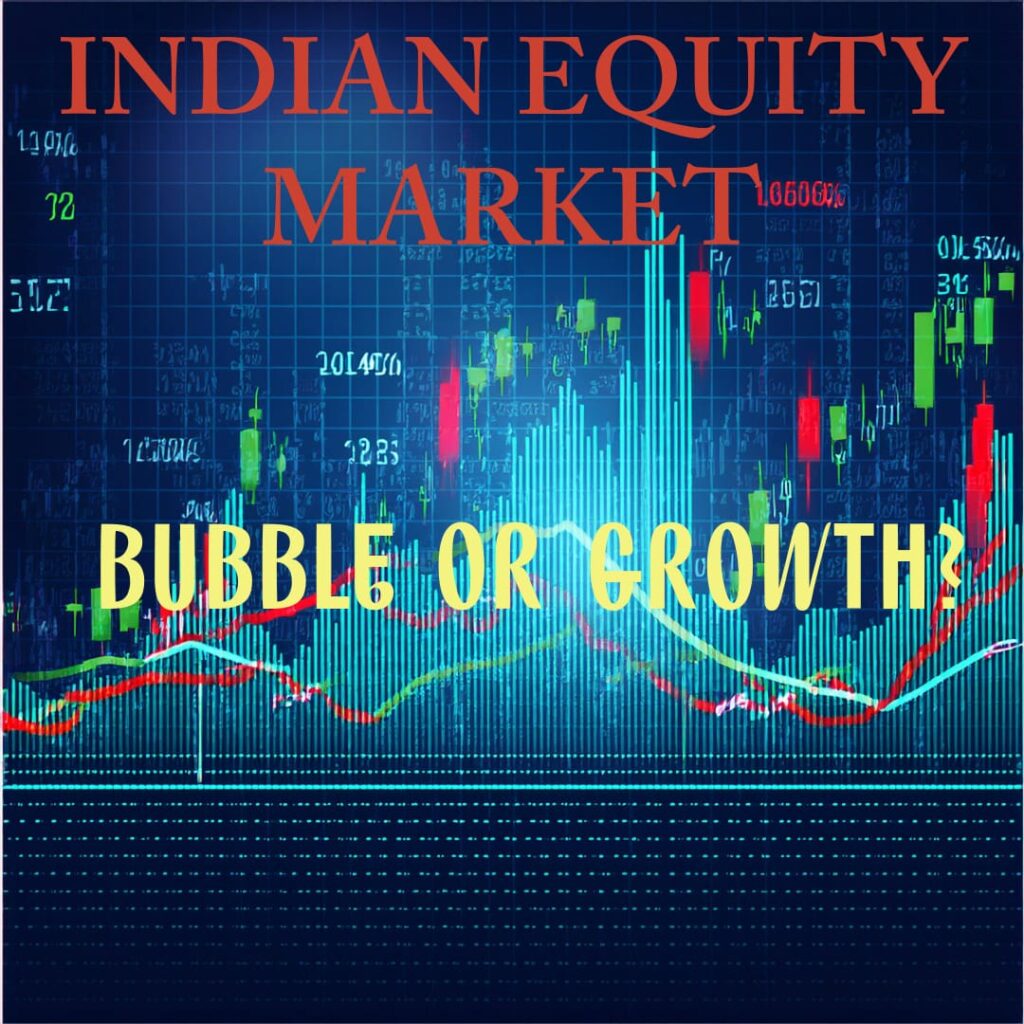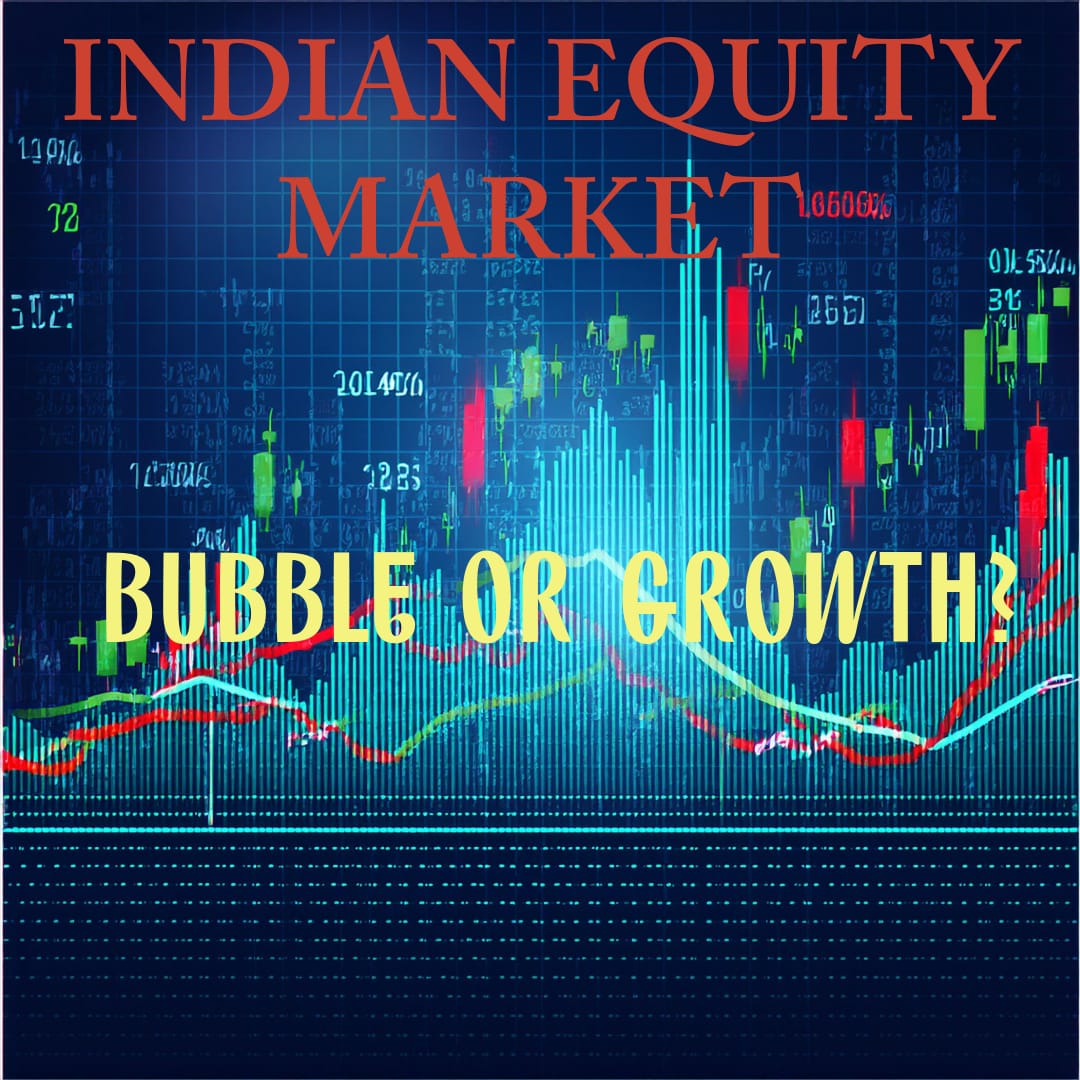Will the Bubble Burst? v/s India Story
India’s rapidly growing equity market has generated a polarized debate, with some analysts warning of an impending bubble, while others champion India’s rise as a global economic powerhouse. To understand the truth behind this debate, we need to explore both arguments thoroughly.
The “Bubble” Argument: Overvaluation and Speculation
1. Record High Valuations:
Critics argue that the Indian stock market is overpriced. As of mid-2024, the price-to-earnings (P/E) ratio of the Nifty 50 Index was around 25-28, significantly above its historical average. High valuations can indicate that stocks are trading above their intrinsic values, and this could be a warning of future corrections.
Global institutional investors, particularly those from the U.S. and Europe, have pointed out that Indian equities are now more expensive than many other emerging markets. For instance, markets in Brazil, South Africa, and Russia have lower P/E ratios but comparable growth prospects. This discrepancy makes some believe that India’s valuations are unsustainable, with investor optimism potentially driving prices higher than the fundamentals justify.
2. Global Liquidity and Interest Rates:
Since the COVID-19 pandemic, central banks around the world, particularly the U.S. Federal Reserve, injected massive amounts of liquidity into the global financial system through quantitative easing and lower interest rates. This has fueled asset price inflation, including stocks. Critics argue that once global central banks begin withdrawing liquidity (via higher interest rates or tapering their asset purchases), the Indian equity market may suffer significant corrections.
Inflation and geopolitical instability (e.g., Russia-Ukraine conflict, oil price fluctuations) can also create volatility, further exacerbating market instability.
3. Retail Investors and Speculative Trading:
A significant portion of trading volume in Indian equities now comes from retail investors. Since the pandemic, there has been a surge in new retail investors, many of whom have little or no prior experience in stock market investing. With easy access to discount brokerage apps and low trading costs, retail investors are driving prices up, often in speculative fashion.
According to a 2023 study by SEBI (Securities and Exchange Board of India), more than 40% of new retail investors do not understand basic investment principles. The rise in speculative trading, especially in futures and options (F&O), adds to concerns about a potential market correction.
Key Concerns:
• Retail enthusiasm and FOMO (Fear of Missing Out) could fuel bubbles in sectors like IT, new-age tech, and electric vehicles (EVs).
• Historically, speculative trading has led to bubbles bursting, like during the dot-com bubble in the early 2000s.

The “India Growth Story” Argument: Long-term Fundamentals and Reforms
1. Strong Macroeconomic Fundamentals:
Supporters of India’s equity market rally emphasize the country’s robust economic fundamentals. India is projected to grow at over 6-7% annually in the coming years, outpacing many other emerging and developed markets. This growth is supported by favorable demographics, with India having the world’s largest working-age population by 2023.
The country has also become a leader in digital transformation, with major government initiatives like Digital India, Aadhaar, and UPI revolutionizing banking, payments, and e-governance. This creates opportunities for tech companies, fintech, and infrastructure projects, which are key drivers of equity market gains.
2. Economic Reforms and Market Potential:
Recent policy reforms have made India more attractive to both domestic and foreign investors. The Production-Linked Incentive (PLI) scheme has boosted manufacturing, and India’s rise as a global manufacturing hub is increasingly apparent, especially as companies seek alternatives to China in a post-COVID world.
The G20 presidency and India’s rising global stature have also drawn attention to its long-term economic potential. Analysts argue that this is not just a speculative boom but the result of India positioning itself as an emerging superpower.
Sectors like banking, pharmaceuticals, renewable energy, and infrastructure are expected to see sustained growth in the coming decade. The rise of India’s middle class and increased consumption will likely fuel sectors like retail, technology, and real estate.
3. Foreign Investment and India’s Appeal:
Foreign investors continue to pour money into Indian equities. In 2023-2024 alone, Foreign Institutional Investors (FIIs) invested over ₹1.5 lakh crore into Indian markets. India’s appeal as a stable democracy with strong institutions, combined with its commitment to sustainability and green energy, makes it a magnet for long-term capital.
While FIIs have been net buyers, Domestic Institutional Investors (DIIs), such as mutual funds and pension funds, have also played a crucial role in providing liquidity and stability to the markets. India’s growing pool of domestic savings further supports the markets.
Supporting Data and Facts
• Market Capitalization: As of August 2024, India’s total stock market capitalization exceeded $3.7 trillion, making it the fifth-largest equity market globally.
• Foreign Direct Investment (FDI): India attracted $85 billion in FDI in 2023, reflecting growing confidence in India’s economic future.
• GDP Growth: India is expected to grow at 6.1% in 2024, positioning itself among the fastest-growing major economies.
• Sector Performance: Sectors like IT and financial services have seen strong growth. Major companies like TCS, Infosys, and Reliance have consistently delivered solid earnings, justifying their valuation increases.
Who Wins if Many Lose?
While many small retail investors may lose money due to inexperience or speculation, institutional players—hedge funds, mutual funds, FIIs, and algorithms—often benefit from market volatility. These institutions employ sophisticated strategies to manage risk, while retail investors may be more prone to emotional trading and lack of diversification.
Moreover, companies that list their stocks during a bull market also win by raising capital at higher valuations, which they can invest in future growth.
Is the Market Ethically Managed?
From an ethical perspective, there are concerns about the large influx of inexperienced retail investors into complex financial products like derivatives and leverage trading. This can expose vulnerable investors to disproportionate risks. Regulatory bodies like SEBI have worked to protect investors by promoting financial literacy and cracking down on fraudulent practices.
However, market risks are inherent to equity investments, and it’s up to investors to educate themselves. Ethical concerns mainly arise when companies, brokers, or analysts mislead retail investors or when speculative bubbles are deliberately inflated.
Conclusion: Bubble or Growth Story?
In conclusion, the truth lies somewhere in the middle. While the Indian equity market does show signs of overvaluation in certain segments, it is also underpinned by strong long-term fundamentals. Sectors like IT, renewable energy, and infrastructure will likely continue to drive growth, supported by India’s economic reforms and global positioning.
Retail investors need to be cautious and avoid speculative bubbles, focusing on fundamentals and long-term growth. For the most part, India’s rise is not just a bubble but part of a much larger growth story—albeit one that must be approached with caution and sound investment principles.
For further reading:




